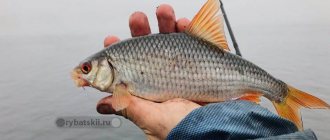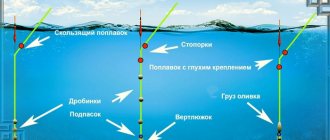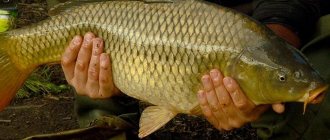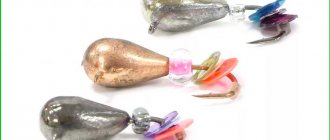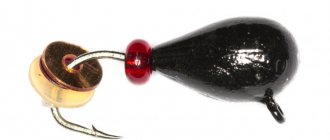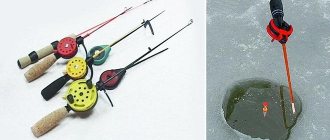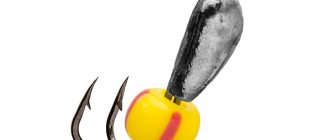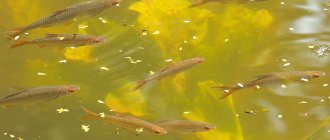The article talks about what is important to know and consider when planning to go fishing in December. Safety precautions when on ice are considered. It tells how and what kind of fish to catch in December.
December is the best period for winter fishing. It is in this month that there is the greatest likelihood of catching a decent trophy. Activity of both white and predatory fish is observed until mid-January. In December, you can successfully catch roach, bream, perch, pike perch, pike, bream, as well as carp and even catfish, if of course it is found in the reservoir. In this article we suggest talking about how to prepare for winter fishing, what is important to consider when choosing gear and bait, and most importantly, how and what kind of fish you can catch.
Fishing in December
As soon as an ice shell covers the surface of reservoirs, fish activity decreases sharply. This is due to the lack of food, the sinking of grass vegetation to the bottom and a drop in oxygen levels in the water. First of all, this applies to small bodies of water, but at the beginning of the month, while the fish are still active and continue to fatten before the onset of the deep winter, its bite can continue for quite a long time.
One of the advantages of winter fishing is the fact that the angler is not limited in choosing where to fish, since thanks to the ice he can stop in any place he likes, cut or drill holes and start fishing. First of all, in early December, you should look for fish in the same places where they pecked during the period of open water - the algae have not yet had time to settle to the bottom and begin to rot, which means there they can find food for themselves in the form of larvae, river fleas, etc. small aquatic life.
The best time for fishing in December is stable weather for 2-3 days, preferably calm and sunny. The fish tries to stay closer to the bottom, where the water has not yet cooled down. Factors that significantly affect the activity of underwater inhabitants and, accordingly, their bite can spoil the pleasure of fishing:
- sudden change in weather;
- change of wind, especially to the north, northwest or northeast;
- drop in atmospheric pressure.
Features of December fishing
Given the peculiarities of our climate, the weather in early December may not always be cold.
However, gradually, step by step, winter takes the reins into its own hands, and the frosts begin to get stronger. The snow stops melting even during the day, and the temperature rarely rises above zero. At the beginning of December, small bodies of water (ponds, lakes and small rivers) are covered with a thin layer of ice, and by the middle of the month the ice becomes thicker and covers larger bodies of water. It is during this period that the winter fishing season begins.
The ideal thickness of ice, which can easily support the weight of an adult, should be at least 5 centimeters. However, following safety rules, you can go out on the ice and fish there only when the ice reaches 12 centimeters thick. In any case, when on ice, you must be extremely careful and constantly monitor the strength of the ice.
Due to the uneven freezing of water bodies, in early December, anglers will have to be content with the fish that live exclusively in shallow water. For example, a significant part of the catch consists of roach and small perch. As the ice becomes thicker, larger inhabitants of the reservoirs, such as pike, pike perch and bream, become available to fishermen.
In December, fishing almost always bears fruit, especially if the fisherman has chosen the right place to fish.
What to fish for in December
Catching predators with large baits is especially successful in December - spinners for vertical trolling, balance beams, all kinds of modifications of large jigs, such as “devil”, “goat” and so on. Each angler selects a rod for vertical trolling according to his own taste and depending on finances - some prefer expensive short spinning rods made of carbon fiber with frost-resistant reels, which are so necessary when fishing at great depths, while others are content with homemade “sticks” made from old bamboo fishing rods, on which the fishing line is wound on special wire reels. Details about catching winter bream

Lovers of catching peaceful fish are divided into two main types: floaters and jigs. Both of them mainly use small winter fishing rods - “balalaikas” (with a reel built into the body) or “fillies”, on which the fishing line is wound directly onto the body of the fishing rod. Float tackle for winter fishing is not much different from summer fishing, as it requires the presence of a float and a sinker. However, there are several important differences:
- the float (usually small) must be completely recessed so as not to freeze to the film of ice formed on the surface of the hole;
- the sinker should be slightly heavier than the float and is usually attached to the end of the tackle, and leashes with hooks are located above.
Jig fishers are a special category of fishermen who, like spinners, prefer an active search for fish to a passive wait for a bite over a hole with a float frozen in the water. Jig tackle is perhaps the simplest of all winter tackles. It consists of a fishing rod with a nod at the end, a fishing line and a jig. Moreover, there are different jigs - regular and reelless. Conventional ones are used mainly with additives - a piece of a worm, maggot, bloodworms, dough, etc. Rewinders are used without refills, as they are designed for active play. Often such jigs are decorated with beads, pieces of rubber bands, seed beads, multi-colored wool, etc. They make them as similar as possible to all kinds of larvae swarming in the bottom silt. Correct play with a reelless bait can provoke even inactive fish to bite, which would not pay attention to the most appetizing bait on the hook of a float rod. Features of winter bream fishing with a reelless bait
Finally, one of the most common winter gear is a reel - a reel on a stand with a weight on a fishing line and a double or triple hook at the end. It involves passive fishing, since the fisherman’s responsibilities are only to attach live bait to the hook, lower the tackle into the water and wait for the signal flag to fly up. Most often, when fishing with a girder, hooking is not even required, since the predator itself hooks after swallowing the bait. Read also: Prey fishing by helicopter
How to catch bream and bream
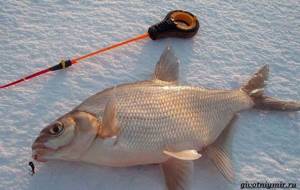
A fishing rod for bream fishing should be sensitive
When summer fishing in open water, bream and bream are usually caught at depth. But in winter, these fish change their behavior. They rise slightly from the bottom and live at a depth of about three meters. They do not like to stay on muddy bottom soil, but they love clay and sand.
If the ice is already thick, then there is less oxygen in the water. As a result, the bream becomes lethargic and does not offer much resistance when fishing. A fishing rod for bream fishing should be sensitive.
It must be supplied with a reel for fishing line. The fishing line is thicker than when fishing for roach or dace. Bream are caught with a jig, moving around a reservoir in search of fish or sitting in one place and feeding the hole.
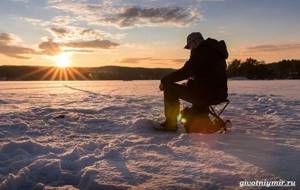
Evening fishing for pike perch
Perch fishing in December
One of the most common fish in winter catches is perch. Perhaps there is no fisherman who would not pull this striped robber out of the hole. They catch perch using spoons, balancers, jigs and a float rod. Only trophy specimens are caught on the girder.
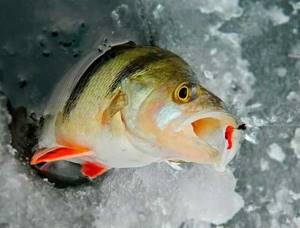
Perch is a schooling fish, which means that successful fishing for it directly depends on finding it. They look for perch near snags, on the edge, near thickets of reeds or cattails, in places with underwater vegetation. The holes are drilled in a checkerboard pattern, starting from the shore and moving towards the center of the reservoir - this makes it easier to determine the depth at which the perch will stand. And the chance of running into a hole also increases sharply.
Useful articles about perch fishing in December:
- Active fishing for perch on the first ice;
- Catching perch on balance beams;
- With a jig behind the perch;
- Ice fishing for perch with a spoon;
- Rating of the best perch balancers;
- Effective tackle "Balda";
- With a reelless reel for perch.
To catch perch, small baits are used - jigs, spinners for vertical spinning, and small balancers. Each angler has his own fishing technique, but it comes down to the same general rules - during a weak bite, playing with the bait should be sluggish and slow, during a feeding season - fast and active. Most often, when the bite is good, fishermen use spinners and reelless baits, since hungry fish grab the bait perfectly even without adding bloodworms or maggots. At the same time, the fisherman does not waste time planting larvae in the cold. For such cases, many fishermen even keep jigs with a sawed-off barb to make it easier to remove the striped robber from the hook.
Video “Fishing through the eyes of a fisherman and fish”
Winter fishing underwater photography from Always Alone
First winter
December is a month when the cold is already beginning to freeze many lakes with ice, but snow and rain are still possible.
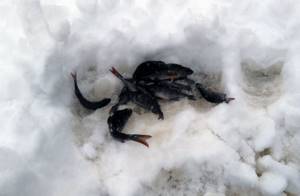
The first winter will last until December 22, and only then does the radical winter come. Ice begins to appear on all bodies of water and anglers rush to go fishing.
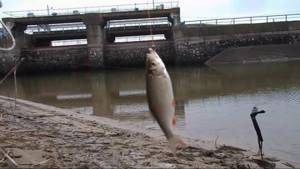
But the ice at this time is quite thin, it can break under you, and going under the ice is very life-threatening.
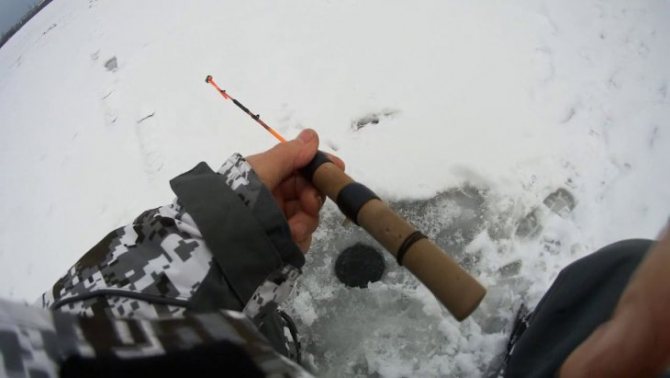
Therefore, we have prepared the following series of rules that must be followed:
Thick ice forms much faster on lakes, but rivers and lakes with underground springs must be treated with caution, as ice appears there later.
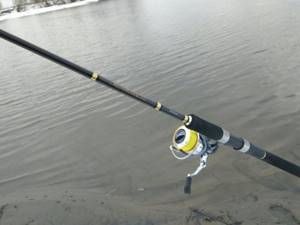
Ice 6 centimeters thick can support a person, but for complete safety the ice must be at least 12 cm thick, which forms around the middle of the month.
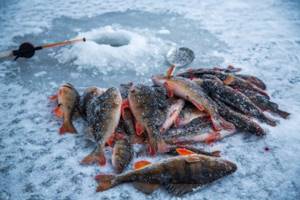
Black ice is considered the strongest, the kind that forms, for example, on Lake Baikal; because of its transparency, the bottom is visible. If you find such a pond for fishing, you can be sure of its strength.
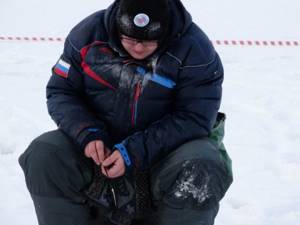
On the Internet you can find a fishing calendar for December, it is compiled taking into account the terrain and weather. On these days, the ice will also become thick and safe for fishing.
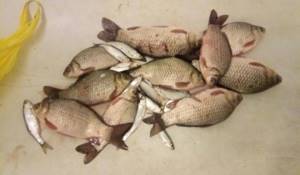
The ice is not strong near thickets of reeds and sedges, so you should not approach such places.
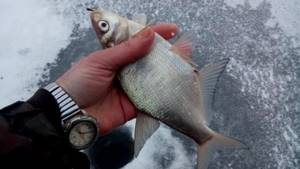
What and where to catch pike in December
December is the best time for pike fishing. She still continues to actively feed and greedily rushes at everything that moves within her vision. Even weather changes are not always able to affect the toothfish’s bite on the first ice.
You need to look for the predator in its usual places:
- near thickets of coastal plants;
- among snags and sunken trees;
- in places where there is a difference in depth;
- at the underwater edges;
- near underwater springs or in places where a stream flows into a reservoir;
- near artificial structures - near bridge supports, piers, etc.
Most often, pike will hang around places where small fish accumulate. If you manage to find a feeding place for the fry, then you can safely catch the toothy predator there - most likely, it will swim somewhere nearby. This is interesting: Catching pike in winter using a balance beam

In December, pike are caught using plumb spoons or jigging rods; balancers are used less often. Lures are large during active biting and medium or small during sluggish biting. Small crucian carp, roach, perch, brushfish and other small things that live in this reservoir are used as live bait. Read also: Spinning fishing for pike in December, as well as with a fallen fish for pike from the ice
Peculiarities of behavior of predatory fish
The main predatory fish species that you can count on catching in open water in December are perch, pike, less often pike perch, as well as burbot in the places where it is found. At the same time, the behavior of predators can sometimes be quite unpredictable. The same perch gathers in schools and follows the main food items to the wintering pits. At the same time, small and medium-sized specimens are usually kept in groups, but trophies are hunted alone. However, often in December, striped predators gather in open water and not far from the shores - this phenomenon is especially often observed in warm, sunny weather at about 10-12 o'clock.
Pike usually stay in quite familiar autumn fishing spots before the ice cover appears, and for several weeks after. You can find it at this time on the coastal edges, near the growth line of reeds, and piles of snags in shallow water.
In December, pike perch can also be found both at depth and in the area of various shallow water spits. Some fishermen even tend to distinguish two separate groups of this fish in the cold season - actively feeding schools and passively standing individuals at great depths. And if in the latter case several tails per day are a good result, then when a hunting group is detected, a good catch is guaranteed.
Roach bite in December
Roach is a capricious fish, and its bite in December is very unstable. The best fishing for this silvery fish will be during sunny, windless weather, in the absence of severe frosts or during a thaw. Unlike summer, in winter roaches bite uncertainly and cautiously. This is interesting: Following the roach on the first ice
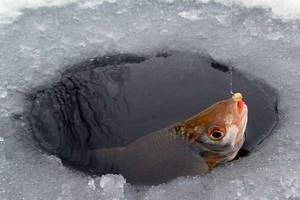
It is best to look for roach in places with underwater vegetation or on a muddy bottom. Most often it is in close proximity to the perch, and if a sailor sits on a jig or hook, then most likely there is a school of roach somewhere nearby. All that remains is to feed her and enjoy the excellent bite. Roach also prefers coastal edges, slopes into the riverbed, and holes. However, it does not always stay near the bottom. Before leaving the feeding area, it is necessary to fish all layers of water - it is possible that the roach will stand right next to the ice. Read also: December roach fishing
It is worth paying special attention to bait, since without it the quantity and quality of the catch can be sharply reduced. As bait, it is better to use purchased mixtures for white fish, created specifically for cold water, but most fishermen prefer homemade bait, using bran, breadcrumbs or cake mixed with live food bloodworms for these purposes. Often, powdered milk is added to the bait to form a cloudy cloud.
They catch roach using a float tackle or jig - both regular and reelless. Active play with the bait is not required - just a sluggish swing of the jig or rare raising and lowering of the float tackle, during which the weight hits the bottom, causing a cloud of turbidity to form, attracting fish to the bait. Bloodworms, maggots, burdocks, pieces of dung worms, dough, bread, etc. are used as bait.
Tips for winter fishing
Drill several holes in the ice at once, even if you don’t have a lot of fishing rods and tackle with you.
This is necessary so that the fish will swim closer to you, because thanks to the holes, it will feel the influx of oxygen in this place. Experienced fishermen advise drilling ice with an ice ax, without using an ice pick. If you did use the last device, then you should not approach the hole for the next 30 minutes, because the noise and crackling have scared away all the fish, and it needs time to recover. It is best to fish in winter using a jig or a spinner. If you are a novice fisherman, then you can attach bait to such a bait, for example a bloodworm or a small worm. If you find a moth larva somewhere, it will be the greatest success, because fish bite on such bait extremely actively.
Many fishermen look for a place to fish using exclusively their fishing sense, but for those who do not yet have it, a miracle of technology has come to the rescue - an echo sounder. This device is attached to the fisherman’s leg and allows you to see all the movements of the fish, estimate how much of it there is in the reservoir, and also estimate the depth and temperature of the water (if you lower the sensor into the water).
After you catch a fish, do not put it on ice, it will freeze. Immediately place it in a special bag or box. To prevent the hole from freezing, pour a little sunflower oil into it. The ice around the hole must be darkened and sprinkled with snow; too transparent water cover scares away the fish. Also, there is no need to put ice fragments next to the hole; they freeze and crunch, which also confuses the catch.
Fishing for pike perch in December
Pike perch, like perch, must be looked for. Even if you somehow find a school of fanged under the ice, it is not at all necessary that it will be caught. Often it is impossible to seduce a passive predator even with the best baits, which means that it is necessary to look for active fish. She will hold:
- along the fishing trails,
- in the pits
- in the whirlpools,
- where rivers flow into large lakes and reservoirs,
- next to schools of small fish.

They catch pike perch using narrow spinners for vertical trolling, hitting them on the bottom. In recent years, balancers or ratlins have become especially popular when catching fangs, which even beginners who have never fished from ice can master. Pike perch also bites on large jigs with live or dead fish, or a piece of fish attached. Some fishermen use fresh frozen sprat, which can be purchased at any supermarket. This is interesting: The best balancers for zander
How to catch crucian carp at this time
Crucian carp sleeps in deep hibernation in winter. Therefore, unfortunately, you won’t be able to catch golden crucian carp in December . But you can try to catch its silver brother. True, it bites weakly, but if the fisherman has an ordinary fishing rod with a nod in his hands and he goes to a pond or lake with a muddy day, then there is a chance to catch a fat crucian carp.
Well, if he doesn’t catch it, then he shouldn’t be discouraged, because crucian carp and perch live next to the crucian carp, and you can catch them with your ear. To catch crucian carp, the jig with bait must be lowered to the bottom and then slightly lifted. The crucian carp will begin to bite after the nozzle is lowered onto the bottom soil.
Burbot fishing in December
The beginning of December is the best time to catch burbot, as it begins its pre-spawning feast, which, depending on the region, can last until mid-January. They catch burbot using a zherlitsa, a winter donka, and a spinner. Most often, anglers use a bottom line with a line of at least 0.3 mm with a sliding sinker and a single hook at the end - burbot swallows bait deeply, and getting double or triple hooks out of its stomach is very problematic.
The best bait when fishing for burbot is live bait. It is more advisable to use fish that lead a bottom lifestyle - minnows or ruffs. They are baited on a donkey hook and left in the hole all night. Sometimes fishermen use frogs as bait, but catching them in winter is not an easy task.
Fans of active burbot fishing prefer all baits (spinners, balancers, large jigs) to sticks, which can be bought in a store or made with your own hands at home (the simplest knocker is made from a lead-filled cartridge case). The essence of fishing with a snitch is to methodically hit the bottom, rocky or pebbly; in places with silt or sand, such tackle will not work.
Favorable days for fishing in December
Favorable days for fishing in December: from 11 to 13, as well as from 25 to 27 of the month. Days when a good fish bite is expected: from 1-3, 5-8, 16-18, 20-22, 30, 31. Poor fish bite: 9, 15, 23, 29.
Read more about fish biting in December here.

What fish to catch in November, where to look for it and what gear to use
Review of Nero ice augers and owner reviews >>
What kind of fish bites
On the first ice it will be good to catch roach, perch, bream, and ruff. You should look for this fish at a depth of 1.5-2 meters. The most promising places are areas a few meters from the reed thickets, as well as the borders of the exit from the bays. Predators (pike perch, pike, large perch) should always be looked for near areas where peaceful fish are caught.
To catch predatory fish, girders are mainly used, which are equipped with live bait; they are installed in creeks and near reed thickets. You can expect pike or perch as a trophy in the daytime; in the dark, there is every chance of catching a pike perch. Also, predatory fish are caught with great success in December using balancers and spoons. Perch is caught with a nodding rod, which is equipped with a jig or a small balancer.
Roach, ruffe, and small perch are most often caught with winter float rods, which are equipped with jigs or regular hooks. Bloodworms, dung worms or maggots are used as bait. You should always start looking for peaceful fish in the shallows in December. Often, a school of roach, especially in warm and calm weather, will stay in the coastal zone with a clean and hard bottom.
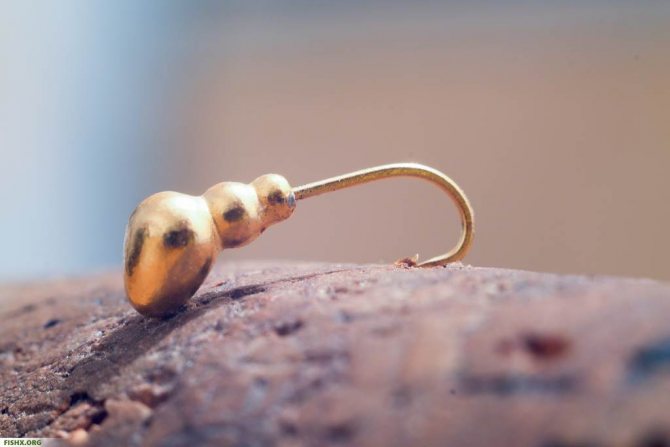
Bream and bream will be best caught next to a calm current. For fishing, a nodding or float rod equipped with a small jig is used. Excellent results can be obtained if fishing is done with a herringbone rig.
Ruff is well caught almost throughout the reservoir; this fish is not whimsical; it is most attracted to the muddy bottom. The most promising place for catching ruffe is an area a meter from the reeds, in a bay with a depth of a meter. If you plan to catch bream, then in this case you will need to take a more responsible approach to preparing your gear. You need to start looking for bream at the edge of the depth difference, at the exits from the pits. Note that bream are more attracted to a hard clay bottom.
Burbot and pike perch are nocturnal predators. It is important to know that burbot will be caught best in bad weather (severe frost, snowfall). For parking, these predators choose deep pools with a rocky bottom. You can catch burbot and pike perch using live bait, as well as special winter lures, which are sold in absolutely all fishing stores today.

